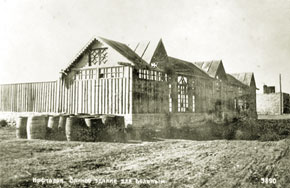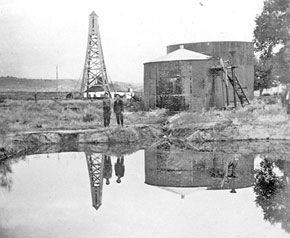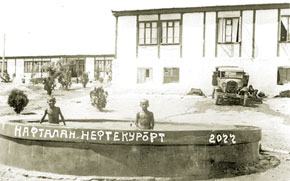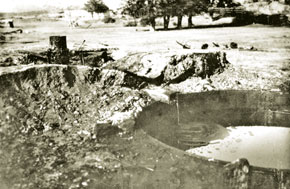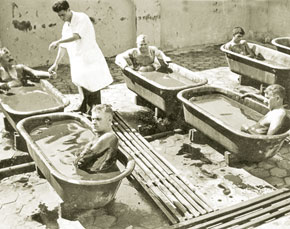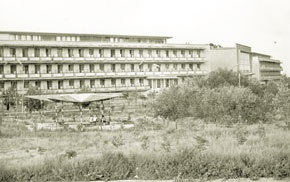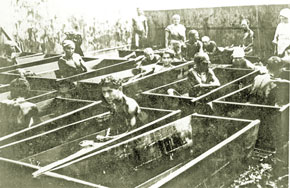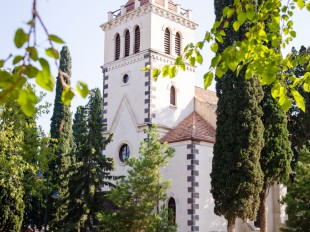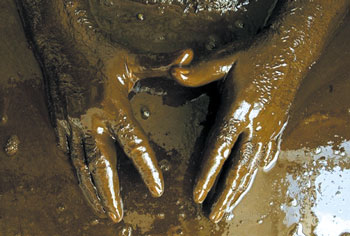 Pages 66-71
Pages 66-71by Vusala Zahirova
One of Azerbaijan´s unique resources is a rare type of oil - Naftalan - which is renowned worldwide for its medicinal properties. Providing a variation on the concept of bath oil, Naftalan is used both externally and internally. Doctors say Naftalan relieves joint and bone disease, cures psoriasis, calms the nerves and beautifies the skin. Naftalan comes from the Azerbaijani neft alan ("a buyer of oil"). The town of Naftalan, home to the Naftalan oilfield, is 320 km west of Baku in Goranboy District, on the south-eastern edge of the Caucasus Mountains.
Ancient and uncertain history
The first use of Naftalan oil is lost in the mists of time. According to one story, a medieval herder decided to leave behind a particularly sick, mangy camel. The beast rolled over into an oil pool and was left for dead. But when the herder returned some weeks later, he found the camel miraculously cured. He credited the oil for healing the camel.
According to medieval annals, most ailments were cured some days after treatment. The medical significance of Naftalan was known not only among the local population but also far beyond Azerbaijan. People came for treatment from China, India, Afghanistan, Iran, Turkey and Central Asia. When they left Naftalan, they took some oil to continue treatment at home. This was the first, unorganized "export" of Naftalan oil. Archaeological finds of gold and silver coins in the region and written documents of the 12th century show how the oil was used medicinally. A group of merchants later formed who sold Naftalan oil in Iran, Asia Minor and elsewhere in the east.
Azerbaijani poet Nizami (1141-1209) mentions Naftalan oil in his poem Khamsa. He describes Naftalan oil being taken from the village of Seficurd by caravan. Traveller Marco Polo who visited Azerbaijan in the 13th century also refers to Naftalan oil in his writings about Great Tatarstan.
Naftalan becomes popular before First World War
Prospecting, exploitation and processing of Naftalan oil on an industrial scale began in the 19th century. During this period Naftalan oil gained popularity in the west. An area of 48 hectares in Naftalan oilfield was given to eight Germans (four of them were German or Austrian and the others Russian citizens) by the local governor in 1868. One of them, German chemist and engineer K. Yeguer, investigated the chemical properties of the oil. He was very disappointed not to discover petroleum fractions in the oil, as the oil did not burn. When he heard later about the medicinal properties of the oil, with the permission of the Russian tsarist government, Yeguer developed a small factory to produce ointment in 1892 and sold it as an effective medicine. Yeguer´s company enjoyed rapid success. He sent samples of Naftalan ointment to prominent doctors worldwide. Professor List from Magdeburg took great interest in the oil and bought up the product for Germany. Interestingly, Yeguer´s ointment was banned in Russia and was imported there from Germany under patent and sold at a high price. Yeguer produced another ointment based on Naftalan, Kojelan, and this product was also commercially successful. Kojelan oil keeps the body´s skin smooth and protects leather goods and metals.
In 1911-12 another German businessman, Kuel, founded the German-Naftalan Stock Company and launched production of some medicines. Two more stock companies were established - Naftalan in Magdeburg and Naftalan in Dresden - and produced a variety of ointments, pills, pastes, liniments, soaps for soft skin and cosmetic products and exported them to various countries including Russia.
Demand for Naftalan oil and its products increased in a short time in Germany, Britain, France, Japan, Austria and elsewhere. During the Russo-Japanese war every Japanese soldier had Naftalan ointment in his kitbag to treat skin diseases and frostbite. As medicines based on Naftalan oil became famous worldwide, the German producers presented their goods as German medicine rather than Naftalan oil. Between 1868 and 1914 Naftalan oil was extracted from about 20 wells through hand - boring.
Naftalan regains popularity in Soviet period
The First World War stopped Yeguer´s business. The small factory was destroyed and the production formula lost. A new stage in Naftalan production began in 1927. Ten wells were restored and exploitation was entrusted to the Azerdagkimya Trust (in the former USSR, a group of industrial or commercial enterprises with centralized direction) and a health centre was founded. Prospecting and drilling continued and a new settlement was founded in the region. In 1929 Naftalan lubricating oil was prepared according to Yarkho´s formula. The number of people receiving treatment in Naftalan increased rapidly, growing from 920 to 3,000 between 1929 and 1932. The geological structure of the area, oil strata and working regime of the wells were determined. Exploitation rose every year. In 1931 a Naftalan division was opened at the National Health Committee´s Clinical Research Centre. High-quality Naftalan products were made at the Nafatalan experimental plant and Azerbaijani Resort Institution. During the Second World War Naftomastica medicine, prepared from Naftalan oil, was widely used in hospitals to treat injuries, traumatic arthritis, burns and frostbite.
The geological features of the Naftalan oilfield were initially studied by Russian scientist Strizhinov and more comprehensively by Academician Gubkin, Bogachev, Suliv and Sultanov. The field is currently exploited by SOCAR´s (State Oil Company of the Azerbaijan Republic´s) Azneft production unit.
Products made from purified Naftalan can today be found in many pharmacies in Azerbaijan. They are also used in physiotherapy centres in Baku and across the country.
Chemical analysis
The first studies of Naftalan were made by the Russian doctor Rosenbaum. In 1896 he spoke about the impact of Naftalan at a Caucasian Health Society meeting. Later Malishev, Mendeleyev and Burozovich studied the treatment properties of this oil.
Azerbaijani scientist Yusif Mammadaliyev was the first to identify that the healing properties of Naftalan are related to the polycyclic naften hydrocarbons that are the main active ingredients in Naftalan. Academician Ali Quliyev defined the biological specifications and their effects on the organism. This research led to the technique of separating naften hydrocarbons. Physical and chemical analysis reveals that Naftalan differs from other kinds of oil. The density of purified Naftalan ranges from 0.923 to 0.974 grams per cubic centimetre. Naftalan boils at 200-250OC and freezes at -20 to - 30OC. Sulphur and nitrogen are the main ingredients of Naftalan crude, but it also contains a wide variety of micro elements. It contains 50-55per cent naften hydrocarbons (it is about 3-5 per cent for the other kinds of oil), 30-35 per cent aromatic hydrocarbons and 14-16 per cent resinous substances. Naftalan oil does not include light fractions and methane hydrocarbons and does not burn.
Yusif Mammadaliyev discovered that oil from different strata is different. Even oil extracted from the same field at different times is not the same.
Naftalan treatments
Medicine made from Naftalan is used in various external and internal treatments. It is used against inflammation as an anaesthetic and disinfectant. As it penetrates the skin, Naftalan accelerates the metabolic process, thereby boosting cell regeneration. It has a calming, cooling and antiseptic effect, relieves joint pain, cures psoriasis, calms nerves and beautifies the skin. The type of application depends on the specific disease and the doctor´s recommendations. For diseases such as eczema and psoriasis, for instance, Naftalan-based medicine is rubbed on the skin. The oil also helps ultrasound to penetrate more effectively, so is rubbed on the skin before ultrasound is applied. Naftalan is used in tampons and suppositories to reduce internal inflammation and to treat gynaecological problems.
Patients who suffer chronic arthritis have to have ongoing drug treatment. Yet in Azerbaijan patients who undergo 10-days of Naftalan treatment often find that their pain is alleviated for an entire year, meaning that they don´t have to take additional medicine. Patients take baths of Naftalan oil which has been heated to 38OC.
Naftalan crude is a unique resource in Azerbaijan. It holds great promise for international medicine at a time when Azerbaijan´s offshore oil is in great demand on the world fuel market.
